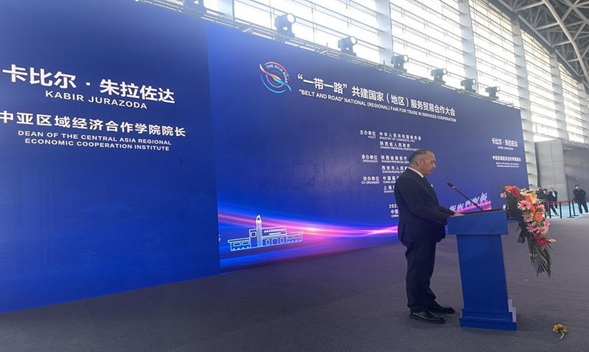CAREC Institute Director Spoke at the Seventh Silk Road International Expo "the Belt and Road" Service Trade Cooperation Conference

On November 16, Mr. Kabir Jurazoda, Director of the CAREC Institute, delivered opening remarks at the 7th Silk Road International Expo “the Belt and Road” Service Trade Cooperation Conference in Xi’an, China. The event was organized by the China Association of Trade in Services with the aim of expanding economic and trade cooperation between the partner countries of the Belt and Road Initiative. The Silk Road International Expo followed the summit of leaders of BRI participating countries in Beijing last month and included a series of forums attended by policymakers, corporate executives, and chamber of commerce representatives.
During his speech, Mr. Kabir Jurazoda noted the unique role of the CAREC Program in reviving the ancient land Silk Road to modern realities by connecting people, policies, and infrastructure projects together for the prosperity of the people. Situated as a land bridge connecting East Asia and Europe, the CAREC countries lie at the heart of the Silk Road Economic Belt. Both CAREC and the Belt and Road share common goals of improving connectivity, promoting unimpeded trade, creating a good investment climate, and strengthening financial cooperation between countries. The five operational clusters of the CAREC Strategy are well aligned with the five-pronged approach of the Belt and Road Initiative.
Being landlocked and lack of access to seaports are geographical constraints for many CAREC countries. More importantly, policy impediments, including lack of economic diversification, transit challenges, and border-crossing complexities, undermine the smooth flow of freight. These have led to high transport costs, documentation challenges, and slow shipment speeds, which prove unfavorable to shippers in international trade. In addition, institutional barriers such as unharmonized standards and corruption were structural and significant. To help countries solve these issues and overcome the challenges, the CAREC Program and the CAREC Institute use the ‘Corridor Performance Measurement and Monitoring’ (CPMM) mechanism to assess and track the time and cost of moving goods by road and by railway across borders and along the six CAREC corridors. Based on the empirical data, the CAREC Program, our Institute and CAREC member-countries launched several strategic initiatives to improve trade facilitation, making the CAREC region an essential land bridge and land link for global trade. Among these efforts are the new Transport Strategy 2030 and the CAREC Integrated Trade Agenda 2030, two key strategic plans to support CAREC member countries in expanding cross-border transport and logistics infrastructure to address capacity constraints.
The regional cooperation of the CAREC countries under these strategic initiatives helps improve trade and connectivity. The most recent data from CPMM shows significant improvement in cargo shipment in the CAREC region, when compared to the previous year. In 2022, the average border-crossing time and cost decreased. The total cost of transport was also reduced. Both speed without delay, which measures the condition of physical infrastructure, and speed with delay as an indicator of the efficiency of border crossing points along the corridors, increased in 2022.
Mr. Kabir Jurazoda also held a partnership meeting with the leadership of the China Association of Trade in Services to discuss cooperation in the CAREC region in such areas as training and knowledge-sharing activities on agricultural development, incubation of e-commerce platforms, Chinese medicine services, green development, single window construction, and infrastructure construction.